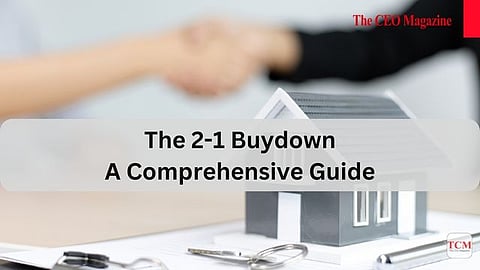
- News
- Women
- Magazine
- IndustryIndustry
- InsightsInsights
- Success Stories
- PublishPublish
- ContactContact
- Media KitMedia Kit

The 2-1 Buydown
A Comprehensive Guide
In the ever-evolving realm of real estate financing, savvy investors and homeowners are continually seeking innovative strategies to optimise their financial opportunities.
One such tactic that has gained traction in recent years is the utilisation of 2-1 buy down loans. Offering a unique blend of short-term affordability and long-term stability, these mortgage agreements have emerged as a valuable tool for both buyers and sellers alike.
In this comprehensive guide, we'll delve into the intricacies of 2-1 buy down loans, exploring how they work, their potential benefits and drawbacks, and when they might be the right choice for your real estate endeavours.
At its core, a 2-1 buydown loan is a specialised mortgage arrangement that provides borrowers with a reduced interest rate for the initial years of the loan term.
The "2-1" designation refers to the gradual adjustment of the interest rate over time: during the first year, the rate is typically lowered by two percentage points, followed by a one-percentage-point reduction in the second year. After this initial period, the interest rate stabilises at the full, permanent rate for the remainder of the loan term.
The mechanics of a 2-1 buydown loan involve a transitional phase where the interest rate gradually escalates until it reaches the standard rate.
To compensate for the reduced interest income during the buydown period, lenders may impose additional fees or require upfront payments from either the borrower or the seller.
These payments, often in the form of mortgage points or lump sums deposited into an escrow account, help subsidise the borrower's reduced monthly payments during the initial years of the loan.
To illustrate, let's consider a hypothetical scenario where a real estate developer offers a 2-1 buydown on their properties.
With the prevailing interest rate for 30-year mortgages set at 5%, a prospective buyer could secure a mortgage with a reduced rate of 3% for the first year, followed by 4% in the second year, before reverting to the standard 5% rate thereafter.
For instance, on a $200,000 mortgage, monthly payments would amount to $843 in the first year, $995 in the second year, and $1,074 thereafter.
For sellers, 2-1 buydown loans can serve as a powerful incentive to attract buyers and expedite the sale process. By offering reduced initial payments, sellers can make their properties more appealing without necessarily lowering the sale price.
However, it's essential to consider the associated costs, as buydowns can impact the seller's net proceeds from the transaction.
For buyers, 2-1 buydown loans offer several potential advantages. The reduced initial payments make homeownership more accessible, allowing buyers to afford larger mortgages and higher-priced properties.
Additionally, the gradual increase in payments provides temporary relief before facing the full repayment burden, which can be particularly beneficial if the buyer's income is expected to increase over time.
Nonetheless, buyers must carefully assess their long-term affordability and the potential risks associated with rising mortgage payments.
Home sellers facing challenges in a competitive market may find 2-1 buydowns instrumental in attracting potential buyers and closing deals swiftly.
Conversely, prospective buyers should conduct thorough due diligence to ensure that the buydown arrangement aligns with their financial goals and circumstances. It's also essential to work with reputable lenders who offer transparent terms and competitive rates.
In conclusion, 2-1 buydown loans represent a dynamic and flexible option for both buyers and sellers in the real estate market.
By understanding the mechanics, benefits, and potential pitfalls of these specialised mortgage agreements, investors and homeowners can make informed decisions to maximise their real estate potential.
Whether you're looking to sell your property quickly or secure affordable financing for your dream home, exploring the possibilities of 2-1 buydown loans could be the key to unlocking your success in today's competitive real estate landscape.
Follow us on Google News
